

VICTORVILLE, CA—Following the general trend seen all over the country, there’s been a push around these parts to convince people that the recession will soon be a thing of the past. Local papers have been publishing articles with laughable headlines like “SoCal housing market may be stabilizing” or “Local economy back in growth mode.” Meanwhile, the city of Victorville has been abandoning non-mission-critical development projects, raising utility fees and borrowing from itself like mad to keep a few core development projects afloat to, you know, keep up appearances. Last week, community elders pulled together a who’s who of obscure shills for the 10th Annual High Desert Economic summit, hoping that a pep talk and some community time will help shake out the recession blues.
The Daily Press dedicated a whole series of articles to this event, starting with this announcement:
International economist says High Desert can bounce back
September 08, 2009 5:31 PM
PATRICK THATCHER Staff WriterVICTORVILLE • An internationally known economist who specializes in economic trends says that the High Desert will eventually turn the corner and get back on its feet — but probably not through industries that have driven it in the past.
“What happened to Victorville and Apple Valley and those places as a whole is something we have to look at as a way to re-invent themselves and basically look at how you re-align your economy,” said Joel Kotkin, an international authority on economic, global, political and social trends.
Kotkin is the keynote speaker at the 10th annual High Desert Red Cross Economic Summit on Thursday, where he said he’ll attempt to address the questions: “How did you get in this mess, and how do you get out of it?”
The name Joel Kotkin didn’t ring a bell for me, neither did John Husing, Ph.D., Larry J. Kosmont or any of the other speakers lined up for the event. But I’m still new and haven’t familiarized myself with every “expert” tasked with fluffing up the region’s economic optimism. I did recognize one of the panelists, though: County Supervisor Brad Mitzlefelt. He’s a classic example of the bumbling sleaze that inhabits the local McHalls of Power. Dopey and bearded, Mitzlefelt was the handpicked successor of former Supervisor Bill Postmus, the rising local Republican star who crashed and burned in a magnificent fireball of destruction, the kind that only repressed conservatives manage to pull off.
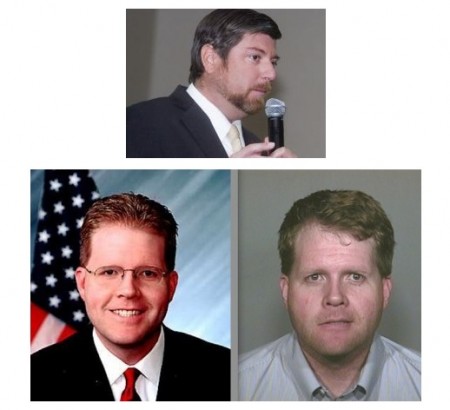
Brad Mitzelfelt (top), Bill Postmus: Before & After (bottom)
Last year, Postmus was investigated for corrupt dealings with real estate developers but was arrested for possession of a controlled substance, which finally outed him as a meth-addled, hopelessly out of control, closeted knob-gobbler. The fallen star was a member of Victorville’s weird, evangelical Jesus-rock High Desert Church by day who would by night commute to the gay hot spots in Hollywood, Palm Springs and Laguna Beach to smoke meth and safely party where no one would recognize him, reported the San Bernardino Sun.
So the conference looked like it had potential, but I couldn’t make it there. And now I regret it. Because having looked over a couple of the PowerPoint presentations put together by its panel of economic gurus, it’s obvious the event must have been one hell of a howler. Here are a few economic revitalization policy recommendation highlights I could glean from their material:

Economist Dr. John Husing, pictured here “making first contact with a lost tribe from the stone age.”
(Check out Husing’s Indiana Jones adventures Web site…)
I’ll start with Dr. John Husing, a “private economist” who specializes in the Inland Empire, because he is unrivaled in his unflinching boosterism and deserves first-class treatment. Just look at this man’s track record:
In 2006, he predicted that Inland Empire was “right on the cusp of a very powerful period in job growth. . . . Is the housing market vulnerable? Yes, it is. But is a bubble likely to happen? No, it is not. The underlying strength of our economy is too great.” In 2007, he doubled down on the optimism: “Historically speaking, the doldrums surrounding the housing market are not as serious as they appear.” In 2008, he pawned his watch, his pinkie ring, and his insect collection and went all in, saying that does not believe “homes ever again will be as affordable as they were in 2000” and that we were entering a “chronic shortage of supply” that will push up prices forever.
Now, in 2009, his zeal has not been blunted one bit. To Dr. Husing, the High Desert had two economic strengths over the competition: dirt and blue collar labor. One of his slides contained a graph showing that San Bernardino County had the highest levels of low education in Southern California, meaning 50.9% of the workforce had nothing more than a high school diploma. And that was a good thing. Something to be proud of and to cultivate because it provided a large work force to lure in manufacturing businesses. But he contradicted himself a few slides later when he started pontificating that America was no longer in the manufacturing business. These days, it was all about service and transportation. Did that mean the High Desert was on its way to becoming a prosperous community of minimum-wage burger flippers, truck drivers, fork lift operators and an upper class made up of prison guards, who would be pulling three times the average minimum wage a slave could make? Actually, yes. It’s already starting to look that way.
Husing admitted that things were bad, but there was a bright light at the end of the tunnel, and it was real estate. Here’s how it would work according to the expert: economic collapse had shot housing affordability sky high (about as affordable as it was in 1999), which in turn created a huge increase in demand and drove up prices. Furthermore, for the past decade, Southern California had not been building enough dwellings to satisfy demand, with the deficit has been running to the tune of 15,670 single family homes a year. That’s right, the industry did not overdevelop. All those empty houses, well, they don’t exist. The next few phases are very logical: lower home values had led to an increase in demand for homes, yet there are not enough homes to meet that demand. But the High Desert has a lot of empty homes, and they are some of the cheapest around. Therefore, people will flock to the High Desert to buy homes, thereby raising real estate values and bringing business and tax revenue with them. That is why Victorville is about to start turning prosperous. Q.E.D.
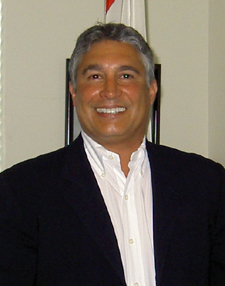
Mr. Kosmont, CRE
Next up were the slides prepared by Larry J. Kosmont, CRE. He’s a high profile real estate consultant and a member of an elite unit within the National Association of Realtors, an honor that allows him to proudly bear the title of “Counselor of Real Estate,” or CRE, next to his name, which he does. A CRE is the Ph.D. of the dirt merchant class. “Membership Means Access,” says a brochure for prospective applicants. “In today’s world of global investment flows, access to the major institutions and funds in the USA is crucial and this is facilitated through the CRE.” How do you get into the club? Well, first you have to hand over a one-time membership fee of $2,500 and then pony up another $1,500 every year thereafter. With this kind of connectedness, Mr. Kosmon, CRE, created the slickest-looking PowerPoint presentation of the bunch, hands down. (Actually, two assistants put it together for him.)
Mr. Kosmont, CRE, outlined a three-pronged attack to beat back the recession in the High Desert. They needed to boost real estate values, increase retail/hotels to draw tax revenue and promote corporate expansion into the area. Now, with the economy being as bad as it is, Kosmon admitted that there was really only one way to actually do that: ask the federal government for money. “Follow the public money,” he wrote. “Keep an eye on your business and an eye out for the federal, state, and local programs that could help your bottom line.” To bring that point home, Kosmont has a slide showing a Clip Art drawing of a little man in a suit carrying huge bag of money and this not so subtle message taking up most of the page:
Kosmont then made a bunch of nonsensical statements. Like this one, for example: “Be keenly aware of Generational Shift in end users of goods and services. Boomers are retiring and Gen-Y is becoming prominent consumers.” Or this one: “Change management will be key. The urgency is here. Adaptability will take foresight and a stomach for risk.” It was clear he was just taking up space and time, keeping busy in front of his geriatric audience that was probably being wowed by his PowerPoint presentation’s animated slide transitions. But in the end, Kosmont’s professional packaging was no match for Dr. Husing’s booster masterpiece, which helps explains why the Good Doctor is one of the most frequently quoted “economists” around these parts.
Now we move on to Joel Kotkin, an “international authority on economic, global, political and social trends” and the star of the show.

Joel Kotkin: author, futurist, thinker and expert on suburban growth
Seeing how Kotkin was a “international authority”, I did a little research on the man. One attendee told me that Kotkin identified himself as a Democrat at the conference, yet he had a dark streak of Reagan worship running through his “work” as a pro-business, pro-growth think-tanker. The man’s been known to defend Reagan and whip himself up into an anti-regulation, anti-liberal froth, alarming the good citizens of suburbia that city planners will take away people’s homes and forcefully relocate them to apartments, if given free reign. But there’s more: not only will they kill the US economy with their centrally-planned poison, but regulation of suburban growth has been proven to cause a decline in birthrates, meaning that city planning literally endangers the very future of America.
But he didn’t inject any of that into his PowerPoint slides. His message was simple and direct: expand the suburbs to the max, empty out the cities, deregulate the economy and remember to leave some space between the tracts for factories, warehouses and whatever else the Invisible Hand, in its infinite wisdom, decides to bless us with. Kotkin is fanatical about horizontal growth. He believes the city is dead and the future lies with suburbia. He loves the sprawl and wants it to spread all over the land like a mold. (I guess that would make him a proponent of pan-urbia, if I may coin a term.)
From what I understand, Kotkin fancies himself a futurist, but the only futurising he does in his presentation is to rehash a few dot-com bubble cliches about how telecommuting is going to revolutionize our lives and our commutes. He’s got a couple of sci-fi quotes floating around to bolster his pan-urbia theory of sprawl:
“Town” and “city‟ will be, in truth, terms as obsolete as “mail coach.”
—H.G. Wells, Anticipations of the Mechanical & Scientific Progress Upon Human Life and Thought (1902)
“The future is already here. It’s just not equally distributed yet.”
—William Gibson author, coined term cyberspace
In slide after slide, he says that suburban life is the pinnacle of modern living. It is not the “brain dead land of ‘Desperate Housewives'” or a “kind of sprawling dystopia” that some make it out to be. He takes us back to the suburban ideal of the 50s with a retro photograph of an idyllic scene: a young mother getting out of her own pool, with a bright red new car in the background, parked right in front of her big new house. The whole family is in the shot, smiling vacant, joker nitrous oxide grins.
But that’s the past. The future, as he shows on a slide with a cheese-ball painting of a fantasy city, is all about “smart sprawl”.
Ain’t that a perty picture? Don’t “village shopping streets and markets” sound nice? Well, I wouldn’t be fooled by Kotkin’s cute, community-oriented rhetoric. If there’s anything in that slide that should be paid attention to, it’s the “archipelago” he’s got up there in the title. No matter how Kotkin phrases it, his vision of a suburban utopia involves a sprawling network tract-home settlements crammed with people ensnared into lifelong mortgage debt.
But as evil as his agenda may be, Kotkin’s presentation was a disappointment, turning out to be the dullest of all the PowerPoints. His faux-intellectualism was no match for Dr. Husing’s wacky economic theories, which helped propel the Doc to the rank of “Low-rent Booster Champion of the High Desert.”
Shill on, you old shiller.

Photo courtesy of www.johnhusing.com
Read more: economy, high desert, pan-urbia, shills, suburban growth, victorville, Yasha Levine, Dispatch


Got something to say to us? Then send us a letter.
Want us to stick around? Donate to The eXiled.
Twitter twerps can follow us at twitter.com/exiledonline




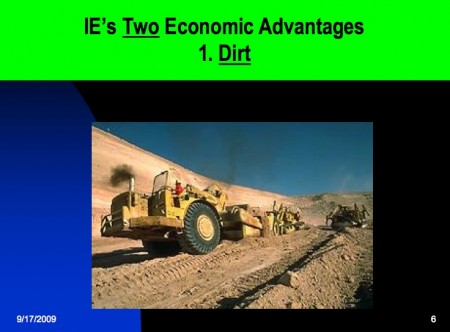

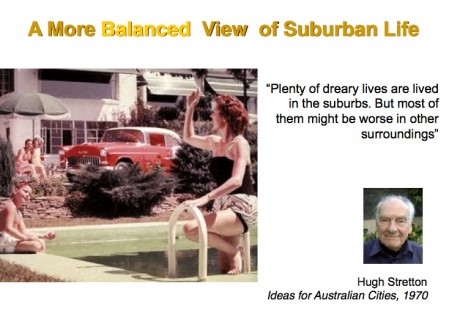
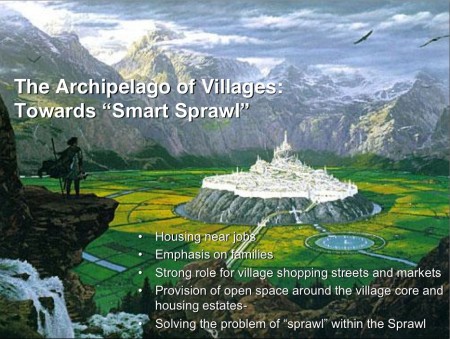








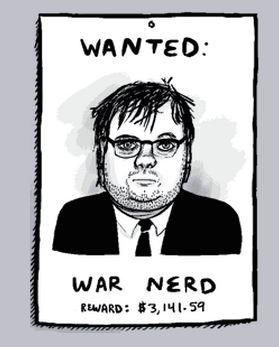

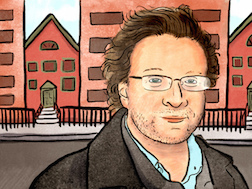
13 Comments
Add your own1. Bardamu | September 22nd, 2009 at 3:08 am
I have yet to find a more consistently argued critique of modern capitalism than that found on these pages. ‘Lifelong mortgage debt’ and similar insights represent a very healthy anathema to the obligatory air-punching delusional optimism of the sales culture. Seldom do we see such a revealing portrait of the empty jargon and private desperation that composes so much of contemporary life. Well done once again, Mr. Levine.
2. Jess | September 22nd, 2009 at 9:18 am
So are suburbs good or are they bad?
I mean, clearly Victorville is quite bad, but after reading this article I’m not sure whether it is a prime example of how suburbs are awful, the crap end of a broad spectrum of suburb quality, or maybe even not really a suburb at all? Can someone help me with my reading comprehension here?
Whatever the answer, if telecommuting takes over, as Kotkin enthuses, no one is going to choose to live in the desert.
3. playin' risk | September 22nd, 2009 at 9:59 am
the suburbs serve to make money for the developers and their political cronies. all that greenfield development is the fastest, more secure way of generation fat profits, but isn’t sustainable in the long run.
even if cars (cause low density urban areas are not conducive to public transit) could run purely on electricity, the other costs of suburbia (higher costs for pipes, electricity grids, maintenance, fire, police, etc.) would still be too high. add in the fact that much of suburban development is funded with municipal bonds, which only serve to defer the actual expense to later generations, we see that the suburbs are on the slow road to hell.
the articles about the ghetto-ization of the burbs, along with the greaseball pseudo-academics involved in perpetrating the fraud, are just the icing on the cake.
academics have long known about these problems. but unfortunately public discourse about urban planning has long been dominated by the development community and their big bux.
4. Josephus P. Franks | September 22nd, 2009 at 10:06 am
It’d be pan-suburbia… pan-urbia would be an all-encompassing urban area.
Another top article, it cracked me up. I couldn’t help thinking, these schmucks manage to make Tom Friedman look competent and wise! No small achievement, that…
5. Carlos | September 22nd, 2009 at 11:36 am
playin’ risk,
I am a thorn in your side.
“the suburbs serve to make money for the developers.” Imagine that. People want to make money building houses. How crass.
Actually, you did bring up a good point about the ghettoization of the suburbs. What’s happened in many U.S. suburbs mirrors what happened in Europe, especially Paris. Suburbs are cheap, people with less money eventually move there, bamm–ghetto. But part of the reason is your bugaboo–developers. They saw urban centers as something that may be attractive to people with money, bought land an buildings, redevolped (in conjuction with their political cronies who rebuilt infrastructure), and priced the poor out of the urban center. So it’s more like ghetto displacement rather than ghettoization.
But I don’t know if “urban planning” solves the problem. What I just described above is considered “urban planning.” And I don’t know if I trust the idea of an urban mastermind telling me where I can or cannot live.
By the way, bonds do defer debt, but how do you think governments get money? It’s either taxes or debt (bonds, treasury bills, etc.). Any urban development would need to be funded by bonds, just like suburban development, but as you pointed out (not that I agree), bonds are the slow road to hell. So if all development is bond funded, the conclusion is we’re all going to hell?
Also, as the population grows, it has to live somewhere and you can’t just keep packing everyone into a finite “urban” space. In fact much of what is considered the urban core of today’s cities was the suburbia of yesteryear. My point is it’s inevitable that the population grows, and it’s inevitable that areas surrounding cities also develop, so suburbs are inevitable. Hell, suburb is a very pure Latin word that Romans from the Roman Empire used because they experienced the same thing we are experiencing–population growth centered around cities.
6. playin' risk | September 22nd, 2009 at 12:16 pm
no carlos, you’re just dumb.
7. antiLeft | September 22nd, 2009 at 1:09 pm
lets get rid of our rail road trackage and pave right over them with roadways, 4 million miles of them in the U.S. so I can get to my destination. Dammit i’m stuck in this traffic jam wasting money on gasoline, insurance and maintenance… Give $300 billion dollars in subsidies for roads, bridges, and highways. Just what we need so the ‘white male construction worker’ can keep his job. Lets neglect our rail road network while we’re at it, of which we only have 140,000 miles of to cover the U.S and is WAY MORE energy efficient in transporting goods.
8. Mads Mikkelsen | September 22nd, 2009 at 1:19 pm
Suburbs are urban planning, which is what makes them so awful. Once upon a time you could build your house however you wanted and the banks didn’t control the entire market because of their infinitely deep well of government-insured credit. So towns just grew with the people in them, and if a place was a shithole, then it was the people who lived there that made a shithole.
But there is a fair point that suburban misery is nothing compared to the urban misery that the rest of the modern world lives in. Check out new neighborhoods in Shanghai, the label Soviet-style doesn’t even apply anymore. And those are the lucky ones. Elsewhere people live in shantytowns with no water or sewers.
Mowing grass sucks but the Victorville-style suburbs don’t even have grass anymore. And sure, you can get a house with your own ball room for 1$ in Detroit built back when American capitalism still had some pride, but then you have to live in a gangster-regime.
9. antinous | September 22nd, 2009 at 2:17 pm
The problem of housing is a vexing one. When the US pop. was smaller suburbs worked fine in cities away from the historical centers like NYC, Phila, etc. Public housing of the 60s, the tall block of flats has been discredited as a viable solution. The current trend (until the crash) of exurbia will be absolutely unsustainable if the price of oil goes to $150 a bbl and stays their (or higher). The Russian model works i.e. apartments given to citizens and a usable network of mass transit worked well for them during their economic crash. This country is in for wrenching change and the free market, buccaneer entrepreneur is not going to provide the answers. Hope it works out..
10. Bartleby | September 22nd, 2009 at 2:33 pm
The smart sprawl village in the last pic looks that Tower City from ‘Lord of the Rings’ plopped down on a sliced off mountaintop. Notice the fortified wall around the perimeter–talk about an urban growth boundary. It must be to defend the city from catapult siege from the former middle class orcs. I like the moat too, nice touch. And what’s with Vasco de Gama on the outcropping? Maybe this guy Kotkin knows something after all?
11. Benjamin | September 22nd, 2009 at 3:07 pm
The city in that image is “The Hidden City of Gondolin,” based on a Tolkien work
12. Anonymous | September 27th, 2009 at 4:12 pm
Jess,
In my opinion, suburbs are worse than cities because there’s so much more expense involved with all that extra distance, longer power, water, communications, and transportation links, everyone having to own and operate a car and buy lots of gas, giant houses to be built and maintained, lawns to be mowed, etc, and there’s no particular payoff for all that extra expense, except that you can make more noise without bothering the neighbors, which is a tiny problem that well-built apartments and condos with thick insulation do a pretty good job of fixing.
Victorville is an exurb, even more remote and recently invented than the suburbs, and even worse about wasting gasoline and driving time.
Almost any job that could be filled by a telecommuter can be filled better either in India or by a computer program on a server in a basement somewhere.
A few people love the big, harsh, empty stark beauty of the desert, and will want to live there, but that beauty is ruined when people build entire cities or suburbs or exurbs out there, and you tend to run out of water if more than a few people live there.
Carlos,
The trick would have been to build dense suburban ghettos for the poor people, instead of sprawl, so that the ghettos didn’t waste a lot of money on useless extra infrastructure, and public transportation could work there.
Urban planning is the kind of government master plan that always makes Americans nervous, but you have to decide how to build roads, water, power, and telecom links somehow. Public transportation too if you have any. So far, an elected government drawing up plans and forcibly buying right-of-way by eminent domain as needed is the least bad method anyone has come up with.
Population doesn’t have to keep growing. It could also be held at about a constant level, with births at about the same rate as deaths.
13. lzzrdgrrl | September 30th, 2009 at 6:03 pm
Our local city of Lino Lakes is talking about pulling a brand new hotel out of its downtown business district development, and converting it into a 70-unit assisted living complex. This will practically kill the downtown business and entertainment project, but since there is no commercial development anyway, they must be going for the federal money in section eight housing……
Leave a Comment
(Open to all. Comments can and will be censored at whim and without warning.)
Subscribe to the comments via RSS Feed